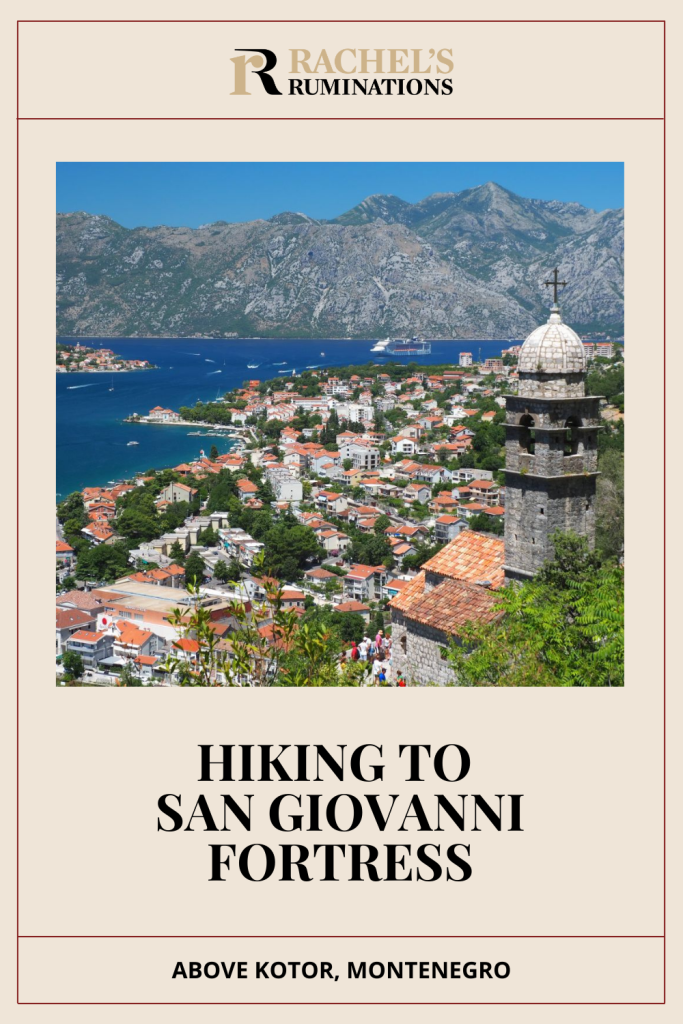Tips for Hiking to San Giovanni Fortress in Kotor, Montenegro
If you are one of those people who is fit and active and actually enjoys hiking, this article probably will seem exaggerated. I’m aiming it at people like me: people who lead rather sedentary lives, and only really get active when they travel. The short version of the story is: I climbed the trail up to San Giovanni Fortress in Kotor (sometimes called Kotor Fortress) and survived to tell the tale.
Disclosure: This article contains affiliate links. If you click on one and make a purchase, I will receive a small commission. This will not affect your price.
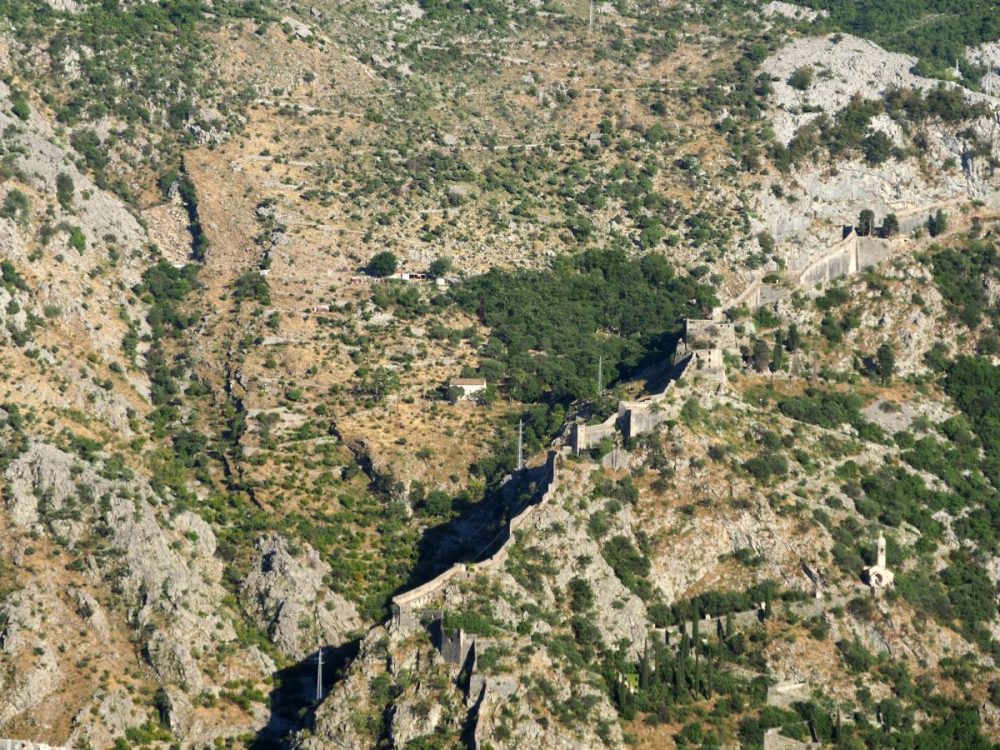
History of San Giovanni Fortress
With its economy based primarily on trade, the medieval Old Town of Kotor sits mostly at sea level, on a triangle of land with the sea on one side, a river on one side, and a steep mountain on the third side. It is surrounded by defensive walls. Over the centuries the city was ruled by a series of masters: first the Illyrians, then the Byzantines, and later the Venetians. While the earlier rulers built fortifications to protect this valuable city, it was primarily the Venetians who were responsible for San Giovanni Fortress (a.k.a. Kotor Fortress) as it stands today. The walls around the city below connected from two points to ramparts climbing the hill above, with occasional watchtowers along its length, all the way to the fortress, 280 meters (919 feet) above sea level.
Kotor Fortress’s record as a defensive structure is not good. Twice the Ottomans successfully besieged it in the 16th and 17th centuries. The Habsburgs took over in 1797, but then the fortress was passed to the French in 1805. Again it was defeated, this time by the British in late 1813. It was soon passed back to the Austrian Empire, but they abandoned it after World War I.
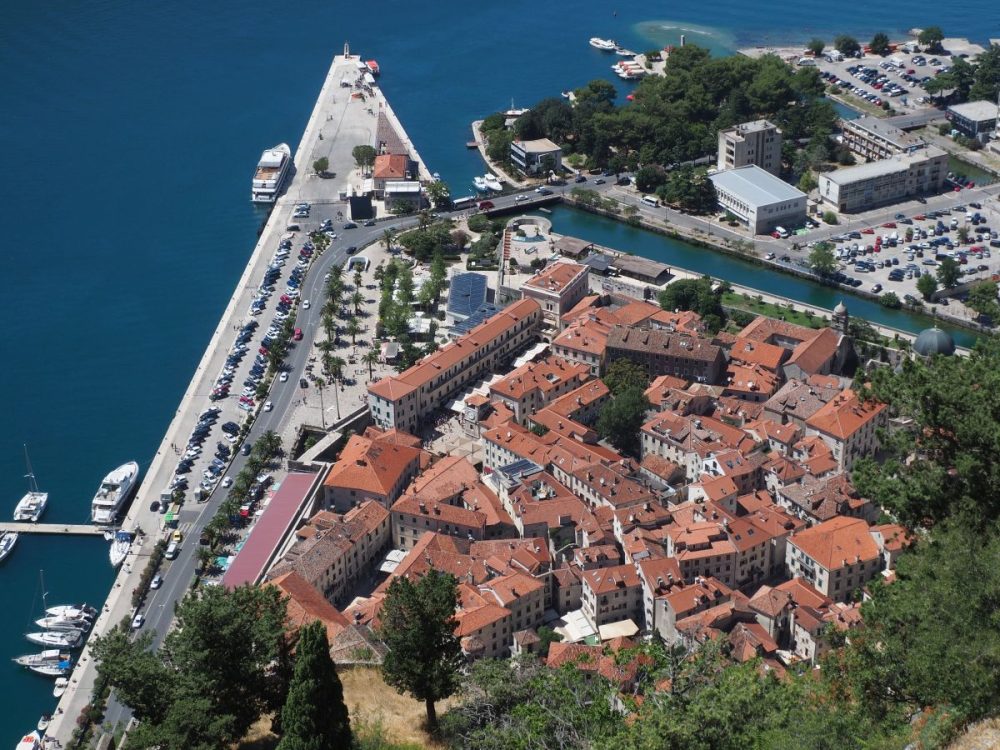
UNESCO World Heritage
Nevertheless, San Giovanni Fortress is part of not one but two UNESCO World Heritage sites. One is a transnational property called “Venetian Works of Defence between 15th and 17th Centuries: Stato da Terra – Western Stato da Mar.” This is a series of six locations in Italy, Croatia and Montenegro which all represent “the designs, adaptations and operations of alla moderna defences.” Apparently alla moderna refers to defensive designs that shifted to accommodate the new technology involving gunpowder. This designation isn’t just about the fortress but about the whole set of Venetian-period defenses around the Old City of Kotor.
The second UNESCO designation is called “Natural and Culturo-Historical Region of Kotor.” It involves Kotor’s outstanding architecture, but also its influence in terms of crafts such as masonry, goldsmithing and iconography. The UNESCO area comprises the nearby village of Perast, some islands, and all of the area around Kotor, including San Giovanni Fortress. After the damage caused by an earthquake in 1979, a comprehensive reconstruction project restored the towns of Kotor and Perast, but the fortress has not yet been addressed.
Make sure to read my tips about Albania if you’ll be traveling there as well!
To climb or not to climb
I knew that this was going to be hard. I knew I wasn’t in shape to do it. But at the same time, I love a pretty view, and I also wanted to be able to say I’d done it. My husband, being in far, far better shape than I am – at 65, he only recently cut his sport schedule down to four evenings a week playing soccer or tennis – was eager to do it. He didn’t pressure me at all, but I suffer from FOMO (fear of missing out), so I decided to go.
Click here for HOTELS IN KOTOR.
The climb up to San Giovanni Fortress
It’s a long, steep climb. The path is wide, and most of it is gravel and rock. For most of its length, though, there is a narrow stone stairway along one side, so you have the choice of climbing a slope or a stairway. I chose the stairway, out of fear of slipping and falling on loose gravel.
I’ve read a variety of reports of how many steps it is to the top. It’s somewhere between 1350 and 1500 steps. I didn’t count, and anyway such a count would be misleading because of the additional sections where there are no stairs: you walk on a slope, mostly in the hairpin turns of the path.
At first it’s a stairway up the hill, not following the wall. About a third of the way up the path reaches a small and charming 16th-century chapel called Our Lady of Remedy. Eventually the path meets and follows the ruined walls of the fortress, which we had spotted easily from across the Bay of Kotor the day before.
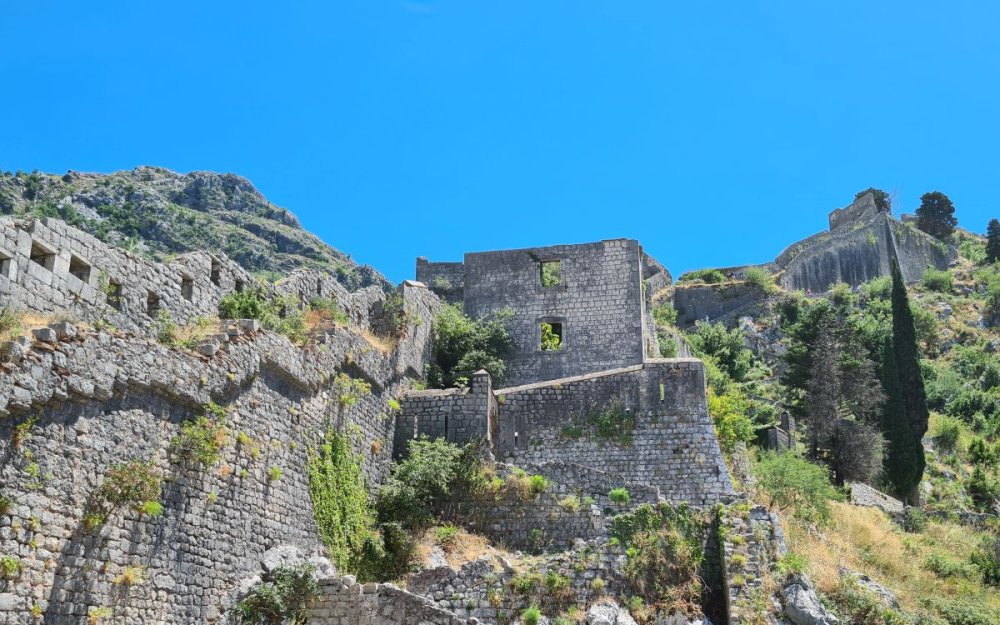
I should add here that we climbed to the fortress during the heatwave that hit all of Europe in July 2022. I didn’t check the temperature, but it was hot: probably in the low 30’s Celsius or about 90 Fahrenheit. The phrase “Mad dogs and Englishmen go out in the midday sun,” from Noel Coward’s very dated song by the same name, kept running through my head as I climbed.
I huffed and puffed like crazy and had to stop to catch my breath after about every 10 or so steps, even more often by the time we reached the top. I was one of the heaviest people climbing, but at least I had good shoes, unlike some I saw who climbed in wedge heels or flip-flops.
My husband deserves a medal for how patient he was about it. I don’t think he got out of breath even once, though he did sweat. He would walk a section ahead of me and wait in the next patch of shade for me to catch up. It was pretty humiliating, but I was determined to finish what I’d started.
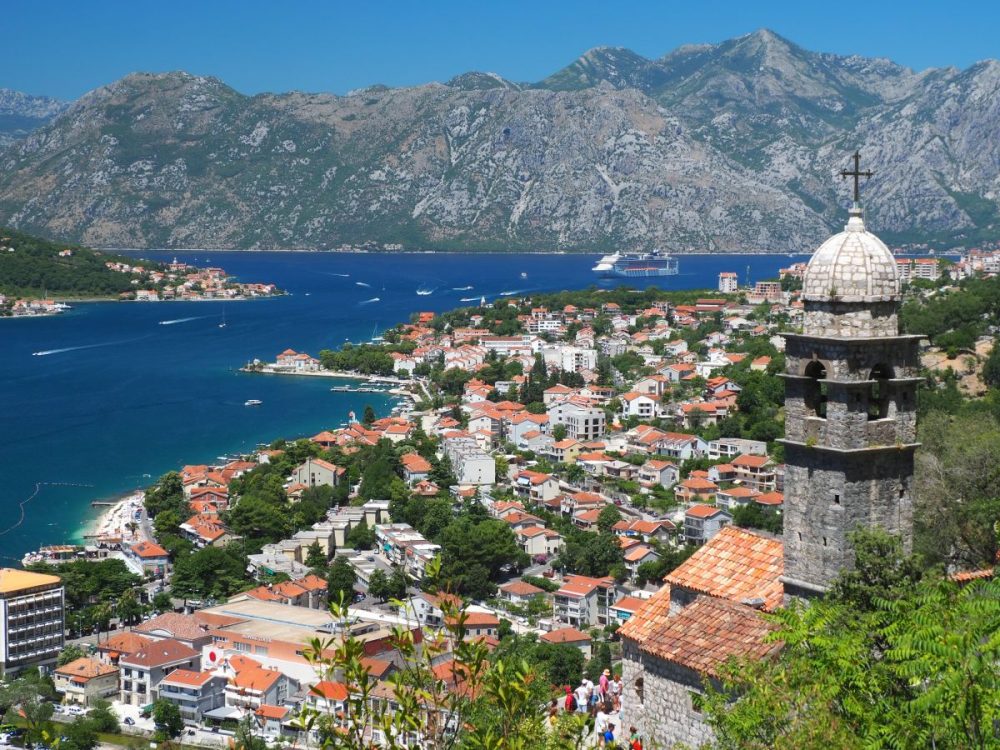
Kotor Fortress
As fortresses go, San Giovanni isn’t that impressive. It’s basically a ruin, and anyone who makes it up there seems to be free to clamber over its walls and through its rooms at will.
So my first bit of advice is not to go there to see a fortress. What makes the climb worth it is the view. The Bay of Kotor is stunning from any angle, and up at the fortress you feel like you can see forever.
Of course, if you don’t want the several hours’ labor of climbing, you could stop at the chapel and enjoy the view from there. Alternatively, you could drive to any of many amazing places to look over the Bay of Kotor.
Anyway, I was proud I did it, even if I took far longer than most.
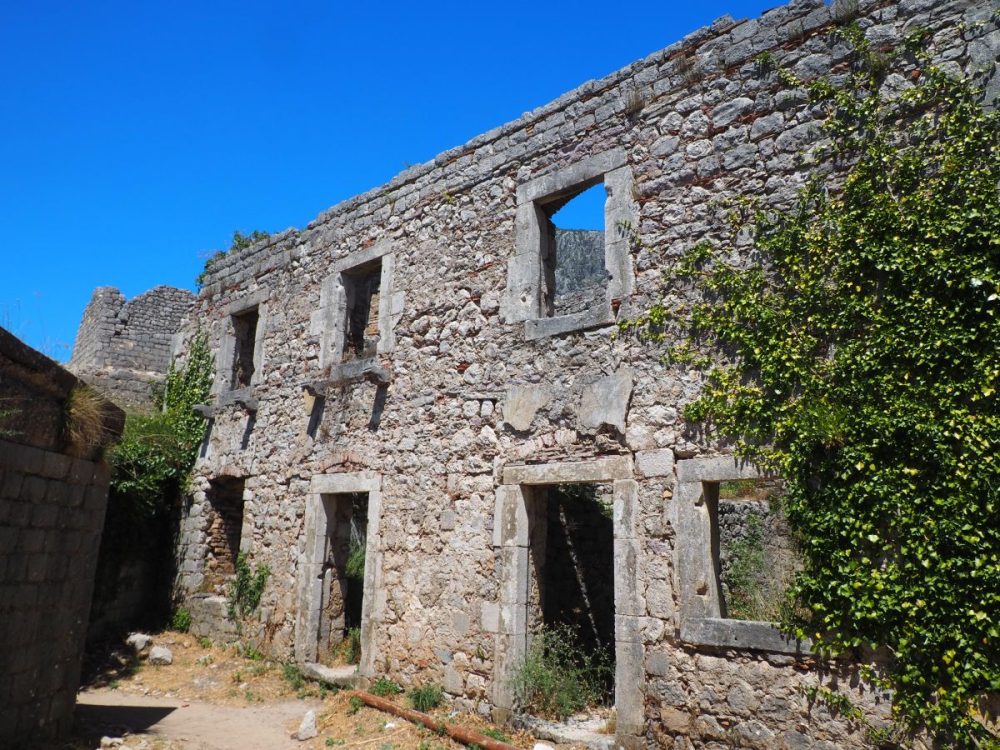
Advice for climbing to San Giovanni Fortress
1. Know what you’re getting into.
This is a long steep climb, and don’t forget you’ll have to climb back down again too. My knees were not at all happy with me by the end of the walk down! If it seems too much, at least try to get as far as the chapel, where the view is wonderful too.
2. Bring water.
Take more than you think you’ll need. I was sweating buckets and dehydrating because of how heavily I was breathing through my mouth. We didn’t bring enough water but were lucky to find a vendor near the top who was selling water. When he sells out, though, which he did soon after we bought our water, he leaves, so don’t count on being able to buy water on the way.
3. Bring food.
I started feeling dizzy – Heat exhaustion? Low blood sugar? I don’t know. – just as we were almost at the fortress. Fortunately, some kind and much better-prepared Americans were there and offered me a handful of almonds. It made all the difference. Trail mix strikes me as the appropriate thing to take along.
4. Bring money.
A short way up from the start of the trail in the Old City of Kotor, you’ll come to an entrance barrier and have to pay a small fee to climb up.
I should point out here that there’s another way to Kotor Fortress that is free, but longer. It’s called Kotor Ladder and it’s a long trail full of switchbacks that starts slightly outside the Old City. I haven’t taken it, but apparently it offers great views of the fortress on the way up.
Other fortresses to read about:
5. Wear solid shoes.
I have a good pair of hiking sandals that are pretty much all I wear when I travel in the summer. They were fine, but if it’s not as hot as when I climbed, you’d be better off with closed shoes like solid walking shoes or hiking boots. You’ll be walking on a lot of sandy gravel and closed shoes are less likely to get sand in them.
6. Consider carefully before taking children along.
We saw quite a few families climbing, and many were fine, but some of the littler children were struggling. Some parents carried smaller children at least part of the way, which couldn’t have been easy.
7. Watch your step.
… every single step. The stairs are uneven and the sloped path even more so. It would be extremely easy to turn an ankle on this walk. On the way down, it’s tempting to start going too fast. We even saw people running down, which is just tempting fate, in my view.
If you have limited mobility, don’t even think about it. There are plenty of other options, as I mentioned above, to see the view without doing the climb.
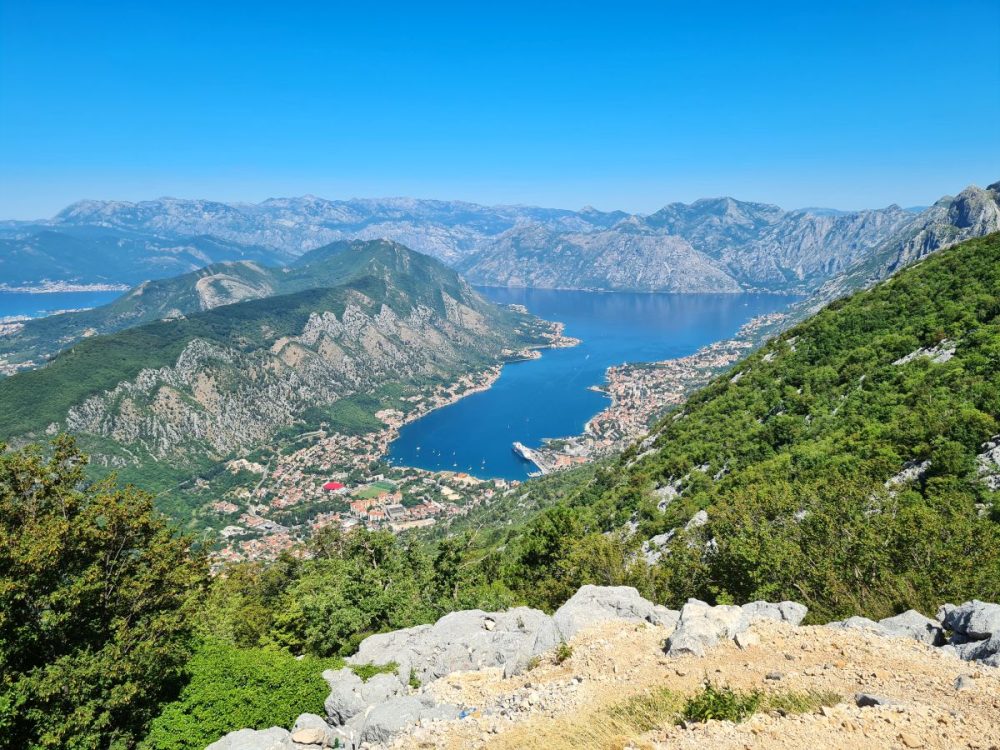
8. Visit off-season.
The height of summer is not the time to do this walk. Actually, this advice goes for the whole coast of Montenegro and Croatia. They’re incredibly popular and teeming with tourists, and did I mention that it’s hot? You’ll be far more comfortable and have significantly less company in, say, April or October.
9. Stay and see other sights in Kotor.
There are plenty of things to do and see in Kotor, particularly in the old walled city. Stay a while and enjoy, especially if you’re there off-season.
Click here for HOTELS IN KOTOR.
Have you been to Kotor and climbed up to San Giovanni Fortress? Add your observations and advice in a comment below!
